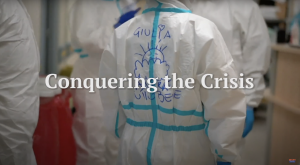6 Creating a Collaborative TV News Special Remotely
Harrison Hove
Course: Electronic News Media 2 (RTV 4301)
Description
 COVID-19 restricted many field experiences for our students. This project creates a hands-on learning opportunity for students in broadcast reporting courses from the safety of their homes. The finished product is a 30-minute television/video news special presentation. Major themes of this project include experiential learning, internationalization, broadcast skill development, and group experience. “Conquering the Crisis” highlighted the pandemic from 12 countries on five continents.
COVID-19 restricted many field experiences for our students. This project creates a hands-on learning opportunity for students in broadcast reporting courses from the safety of their homes. The finished product is a 30-minute television/video news special presentation. Major themes of this project include experiential learning, internationalization, broadcast skill development, and group experience. “Conquering the Crisis” highlighted the pandemic from 12 countries on five continents.
Assignment Goals/Outcomes
The goals for this assignment included utilizing collaborative tools to enhance students’ technological skill set, molding multiple visions together to create a unique, shared vision, demonstrating knowledge at the highest level of Bloom’s Taxonomy (creating), re-imagining work flow to achieve content creation goals when travel and face-to-face interaction is restricted, exposing students to different cultures and global perspectives, and creating professional-level content that could be consumed by a viewing audience.
Assignment Setup (Instructor)
This activity is the culminating experience in a course. Because so many high-level skills are involved, instructors must spend the semester cultivating a student skill set that will enable participant success. Current events naturally dictated the content topic for this special project while local government guidelines shaped the work flow and process.
Student Instructions
Introduce this project clearly and concisely in class (face-to-face or online) and create a handout highlighting project goals, deliverables, requirements and timeline/deadlines.
Instructions for phase 1: On a shared Google Doc (insert link), identify a country, two possible sources living in the country, and a unique story angle related to the Covid-19 pandemic. Make sure your country and story angle are distinctly different from other countries and story angles already listed. Please complete these initial tasks by (insert due date).
Instructions for phase 2: Begin taking steps to gather your content. Contact your previously identified sources and arrange interview times via Zoom. You will record these interviews using the recording feature in Zoom. Make sure you use “speaker view” during your Zoom interview. Additionally, start collecting content for the visual portion of your news story. You can gather visual content by asking sources for user-generated content, use content found on social media platforms with permission, use content in creative commons (please note publishing guidelines so we can give credit as necessary), or content from public domains like government websites. Please complete interviews and visual content gathering by (insert due date).
Instructions for phase 3: Write a two-minute news story in a shared Google doc. On the Google doc, please write an anchor intro, package, and tag. Include all banners. Please utilize proper broadcasting writing style and formatting. Submit for editing and revisions by (insert due date).
Instructions for phase 4: Once your script is approved, edit your news story using Adobe Premiere. Voice your news story by recording your voice on your cell phone. Import all visual content and your newly recorded audio track into Adobe Premiere. Edit the entire package and export the file (H.264, matchsource high bitrate). Use wetransfer.com to send your edited news package for feedback and review.
Grading (Instructor/TA)
Create multiple milestones to give credit for various tasks. Some milestone tasks include selecting a story idea, choosing a country to report on, identifying sources, identifying appropriate video or other visuals, writing the script, editing the story in Adobe Premiere, and final product. Each step requires feedback and helps a student generate momentum. Creating milestones will ensure students are making satisfactory progress and increase the chance of the final product being finished on time and at a high level of quality.
Tips and Suggestions for Instructors
- Allot three to four weeks total for students to achieve all of the steps in each phase.
- Students will hit snags and there should be enough time to overcome these hurdles without compromising the overall quality of the product.
- In phase 1, be prepared to help students refine story angles or suggest sources. Remain positive and helpful.
- In phase 2, students will have challenges gathering video content. Instructor suggestions will be extremely helpful. Knowledge of copyright and other mass communication laws is very helpful as students have limited experience in this realm.
- Phase 3 and 4 will require a lot of time and attention. An instructor should edit and revise scripts in real-time. This ensures each student can proceed and move forward. This is time-consuming, but necessary in order for the project to be high quality and completed on schedule.
- The video editing process also requires real-time feedback so students can make revisions in a timely fashion. Having teaching assistants or upperclassmen to assemble these stories will be a tremendous help. These advanced students can fit the scripts together in the context of a 30-minute news special. They can also coach students through struggles when the instructor cannot manage all students’ needs simultaneously. Student anchors will record their anchor reads using their cell phones and send the video clips back to the instructor. An advanced student will place these video clips in the news special, completing the process. The students have a single deliverable and can see their work shine as a special cumulative group project.
- Most importantly, stay positive and remain outwardly confident. Strategically position each student for success.
Keywords: collaboration, scaffolding, experiential learning, skill development, remote experience
